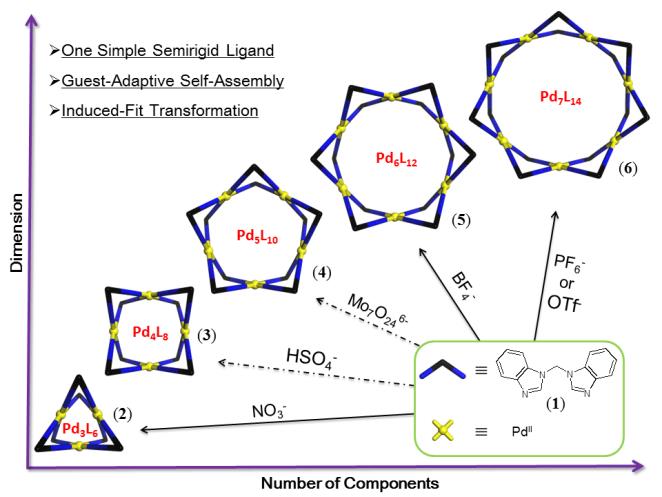
With the increasing application of anion chemistry in biology, environment and food chemistry, design and synthesis of artificial receptors that can recognize and sense specific negative-charged species are of great importance in supramolecular chemistry.
A wide variety of macrocyclic and polyhedral anion receptors with invariant configuration have been reported, exhibiting high selectivity towards targeting anions. Structural adaptive anion receptors which can transform its shape and size in response to different anions have been much less explored.
A research team led by Prof. SUN Qingfu at Fujian Institute of Research on the Structure of Matter (FJIRSM) of Chinese Academy of Sciences (CAS) revealed a dynamic anion-adaptive self-assembly system of MnL2n metal-organic macrocycles in a gradual ring-shrinking mechanism. This study was published in Nature Communication.
In this study, researchers selectively obtained five metal-organic macrocycles PdnL2n (n = 3, 4, 5, 6, 7) in different sizes by direct anion-adaptive self-assembly or induced-fit transformations, which were characterized by nuclear magnetic resonance (NMR), ESI-MS and single crystal diffraction studies. Multiple hydrogen-bonding interactions between the CH from benzoimidazole in the host framework and the trapped anions modulate the formation of the anion-adaptive macrocycles.
Through anion titration experiments, they achieved a comprehensive map depicting the induced-fit transformation processes between different macrocycles, implying a sequence of templating-effect like Mo7O246- > NO3- > SO42- > BF4- > PF4- = OTf- in the dynamic combinatorial system.
During the NO3- anion-templated transformation process from Pd7L14 to Pd3L6, Pd6L12, Pd5L10 and Pd4L8, intermediate macrocycles were observed. The anion guests acted as hydrogen-bonding anchors, which facilitate the gradually shrinking of the macrocycle receptors during the transformation process.
The findings of induced-fit guest-binding mechanism provides new design principles of novel container-molecular for molecular sensing or catalysis.
Previously, this team has reported a molecular receptor with specific binding ability towards nitrate in Chemical Communications which was selected as “inside cover” paper.
This work was supported by National Natural Science Foundation of China, Strategic Priority Research Program of the Chinese Academy of Sciences, and Natural Science Foundation of Fujian Province.

Figure: Self-assembly of anion-binding metal-organic macrocycles (Image by Prof. SUN's Group)

86-10-68597521 (day)
86-10-68597289 (night)

86-10-68511095 (day)
86-10-68512458 (night)

cas_en@cas.cn

52 Sanlihe Rd., Xicheng District,
Beijing, China (100864)

